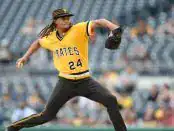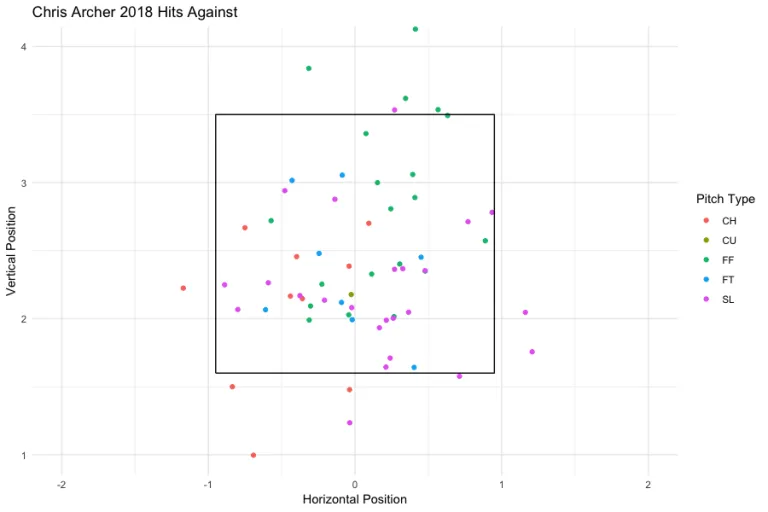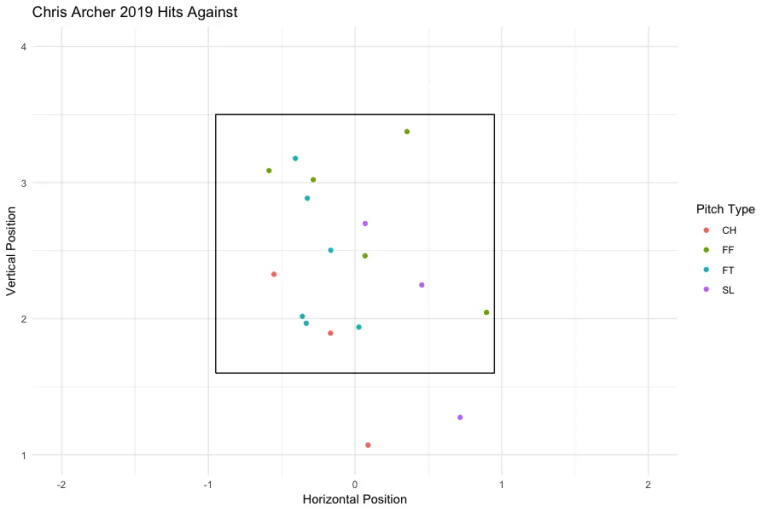Chris Archer: How He Measures Up By Various Metrics

Chris Archer has been good, but not great, so far with the Pirates.
On July 31, 2018, the Pittsburgh Pirates acquired Chris Archer for Austin Meadows, Tyler Glasnow, and a player to be named later. In mid August, the Pirates agreed to send Shane Baz as the player to be named later. Since he became a battlin’ Bucco, Archer has been honestly disappointing. In his 8 years in the major leagues, Archer has 3 seasons with a sub-4.00 ERA: 2013, 2014, and 2015. Furthermore, he has only appeared in the All-Star games twice: 2015 and 2017.
Though he has not always been the best at limiting runs, he does have a knack for striking batters out. In 2015, he had the second most strikeouts (252 Ks) in the AL, behind Chris Sale (274 Ks). The next year, he held his ground by again placing second (233 Ks and tying with Sale) behind future Hall of Famer Justin Verlander (254 Ks). In his last full season in the AL (2017), he was third behind Kluber and Sale. Last year, he amassed 162 punchouts. This sharp decrease is because he sustained some injuries during the 2018 season. We can see that Archer most definitely has talent to strike batters out, but it seems like he still gets burned. This makes me wonder — why is Archer good (or bad)?
Basic Pitching Analysis
Let’s take a deep dive into pitching in the modern day MLB. There are many statistics to analyze pitchers with. For example, we can look at how Archer has performed regardless of the defense behind him. This is called FIP which stands for Fielding Independent Pitching. With FIP, we can see how many runs per 9 innings a pitcher should give up independent of the defense behind him. Here are Archer’s FIP values as well as his xFIP (expected FIP) with differences between the two.
| Season | FIP | xFIP | Difference |
|---|---|---|---|
| 2015 | 2.90 | 3.01 | 0.11 |
| 2016 | 3.81 | 3.41 | -0.40 |
| 2017 | 3.40 | 3.35 | -0.05 |
| 2018 (TB) | 3.62 | 3.63 | 0.01 |
| 2018 (PIT) | 4.00 | 3.53 | -0.47 |
| 2018 (Total) | 3.75 | 3.59 | -0.16 |
| 2019 | 4.80 | 4.66 | -0.14 |
Since 2015, there has been only one season where Archer has surpassed his expected value, 2015. Every other season, he has been forecasted to give up more runs (only based on his pitching) compared to what his expectation should be. Furthermore, when he joined the Pirates last year, he performed his worst since 2015. So far, it doesn’t look promising for Archer.
Batted Ball Analysis
Now, let’s take a look at his batted ball statistics. We’ll be looking at line drive percent (LD%), ground ball percent (GB%), fly ball percent (FB%), and infield fly ball percent (IFFB%). Note that infield fly balls are calculated by taking the number of infield fly balls and diving that by total number of fly balls, not total number of balls in play. Looking at these values give us a better picture on the outcomes of contact against Archer.
| Season | LD% | GB% | FB% | IFFB% |
|---|---|---|---|---|
| 2015 | 20.0% | 46.1% | 33.9% | 7.7% |
| 2016 | 17.7% | 47.8% | 34.5% | 7.6% |
| 2017 | 22.0% | 42.0% | 36.0% | 9.4% |
| 2018 (TB) | 23.6% | 44.7% | 31.6% | 9.2% |
| 2018 (PIT) | 21.8% | 44.4% | 33.8% | 12.5% |
| 2018 (Total) | 23.0% | 44.6% | 32.4% | 10.4% |
| 2019 | 19.1% | 32.4% | 48.5% | 9.1% |
Let’s put these values in perspective. Here are Archer’s differences from the league average for each of his seasons.
| Season | LD% | GB% | FB% | IFFB% |
|---|---|---|---|---|
| 2015 | -0.9% | 0.8% | 0.1% | -1.8% |
| 2016 | -3.0% | 3.1% | -0.1% | -2.1 |
| 2017 | 1.7% | -2.2% | 0.5% | -0.2% |
| 2018 (TB) | 2.1% | 1.5% | -3.8% | -1.1% |
| 2018 (PIT) | 0.3% | 1.2% | -1.6% | 2.2% |
| 2018 (Total) | 1.5% | 1.4% | -3.0% | 0.1% |
| 2019 | -0.9% | -10.6% | 12.4% | -0.4% |
Now, let me put them into perspective. Ideally, when Archer isn’t striking a player out, he would be either getting ground balls or infield popups. Compared to the league he usually gets more ground balls but not more infield popups. I’ll accept just the ground balls as a success since infield popups are significantly more rare. However, I want to point out one value in particular: -10.6%. This season, Chris Archer has more than 10% less ground balls compared to a league average pitcher. When he was traded for, the Pirates should have expected an ace or a solid second option to Jameson Taillon. However, Archer has not performed up to that level. Compared to Taillon this year, Archer has obtained 17.2% less ground balls. Taillon, a developing ace and near star for the Pirates, is performing like an ace, while Archer is regressing to a mid-rotation level pitcher. So far this season has not looked good for the veteran Chris Archer.
Advanced Statistic Analysis
Maybe Archer isn’t a ground ball pitcher. So instead let’s take a look at some more advanced statistics: BABIP, SIERA, and WAR. Before we jump into the data, let me define them. Batting average on balls in play (BABIP) is a simple equation to determine the batting average when a ball is put into play. The equation goes as follows:
BABIP = (H – HR) (AB – K – HR + SF)
The next statistic is SIERA or Skill-Interactive ERA. This statistic attempts to answer the following question: how skilled is this pitcher? With the SIERA value comes a chart of how to interpret it.
| SIERA | Performance |
|---|---|
| 5.00 | Awful |
| 4.50 | Poor |
| 4.20 | Below Average |
| 3.90 | Average |
| 3.75 | Above Average |
| 3.25 | Great |
| 2.90 | Excellent |
With this conversion table, we can interpret SIERA. This leaves us WAR or Wins Above Replacement. This statistic helps us see how many games did the player help the team win. Now, let’s look at how Archer has performed with these statistics since 2015.
| Season | BABIP | SIERA | WAR |
|---|---|---|---|
| 2015 | 0.295 | 3.08 | 5.1 |
| 2016 | 0.296 | 3.50 | 3.0 |
| 2017 | 0.325 | 3.44 | 4.5 |
| 2018 (TB) | 0.343 | 3.77 | 1.8 |
| 2018 (PIT) | 0.328 | 3.65 | 0.8 |
| 2018 (Total) | 0.338 | 3.73 | 2.6 |
| 2019 | 0.273 | 4.37 | 0.2 |
With numbers like these, it is hard to say that Archer has gotten better since 2015. With his WAR jumping, it is hard to determine his overall consistency. Furthermore, his SIERA leads us to say he is somewhere between below average and great. Consistency issues show themselves again. Finally, his BABIP has shown an increasing trend until this season. Archer seemingly has not been a consistent pitcher year to year.
I am not one to make outrageous claims, but from the data, we see that the trade to give up Meadows, Glasnow, and Baz for an inconsistent 29 year old (at the time) has not turned out well. The Pirates invested too much into acquiring an arm that may be past its prime. Archer is no longer the ace he was in 2015. He is no longer the solid second option he performed as in 2017. Chris Archer is not worth what the Pirates gave up.
Hits Against Analysis
Now hindsight bias is always 20/20. All this information leaves me asking myself: what can the Pirates expect out of Chris Archer? These next few graphs should show how he has performed, and how he is not living up to organizational expectations.
First, when Archer arrived in Pittsburgh, it was said that he is a strikeout pitcher who will either be the ace or the number two to Jameson Taillon. Let’s see how he fared in 2018 with the Pirates.
To put it lightly, I am not impressed. Of the 63 hits Archer gave up, 12 occurred outside of the strike zone, shown in black. So, that means 80.9% of all hits against Archer were from inside the strike zone. Pair this with a BABIP of 0.338 and we can say that there was a good chance that if the ball was over the plate, the batter would at least get the barrel to the ball, if not put the ball in play. Furthermore, of the 63 hits, 24 came on his slider while 20 came from his four-seam fastball. Everything that the scouts and organization told us about Archer seemingly is the opposite from the performance.
Now, let’s take a look at this year.
We can see that Archer once again is being beat near the middle of the zone. However, let’s take a look at the frequency of the pitches. Of the 17 hits he’s given up this year in only 5 starts, 6 have come from his 2-seam fastball, 5 from his 4-seam fastball, and 3 from both the slider and changeup. The intriguing fact of this is that no one has hit his curveball this season. Additionally, his slider has less hits than either of his fastballs. It seems like he has gained more control of his strikeout pitch. This is improvement which I can take.
Conclusion
In the end, Chris Archer seems to be a project for pitching coach Ray Searage. Though he’s 30, I believe that there is improvement to be made for the veteran. His control issues have haunted him in the past with Tampa Bay, but this doesn’t mean all hope is lost. After looking at the data for the past 4 years on Chris Archer, there are a lot of positives. His strikeouts are always high. He has excellent break in his slider and is adding a changeup and curveball. His fastballs are used as a setup to his slider and not as an attacking pitch. He uses the slider to either make hitters chase or fool hitters when he throws it up in the zone. However, adding an aging pitcher with minor control issues is not worth two top prospects and a recent first round pick. In conclusion, Chris Archer is good, but not good enough for what the Pirates gave up.
Note: all data has been taken from Baseball Reference, Fangraphs, and MLB Statcast.



I could not agree more. They should’ve traded for Gausman, who would’ve been cheaper.
Thanks for the in depth look at Archer. And in particular, THANK YOU for saying “. . . Chris Archer is good, but not good enough for what the Pirates gave up.”
I’ve never been a fan of the trade that brought him to the Pirates. I felt it was “name” chasing instead of an actual improvement because Archer, IMO, has never lived up to his East Coast hype. I see Meadows as one of those guys who is going to burn bright for a bit, but his constant injury issue (whether his fault, or just bad luck) is always going to be lurking around the corner. And Glasnow was never going to reach his peak with the Pirates, he needed someone new talking to his head. Despite their flaws, I think they help the Pirates win more games than Archer does. Baz (?) I have no idea, but if a guy is a 1st rounder someone must think highly of him.
The Pirates have traded away several young guys who have talent (at least enough to hang around in The Show for a while) but none with the Talents of Glasnow or Meadows. [Broxton once hit 20 HRs in a season, but he has an almost 37% K rate and can’t find playing opportunities. Jacoby Jones, Alen Hanson, Jordan Luplow and even Max Moroff have a good game every now and then but for the most part as replaceable.] Archer has to pick it up, or else this trade will haunt a lot of folks.